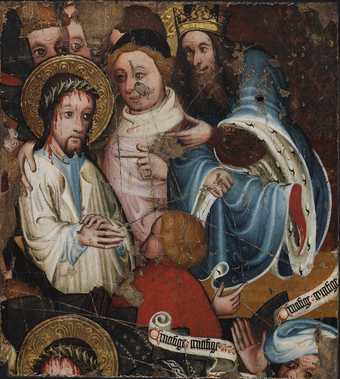
Anon, Christ before Pilate c.1400–25
© The Fitzwilliam Museum, Cambridge
Linbury Galleries, Tate Britain
2 October 2013 – 5 January 2014
Adult £14.50, Concession £12.50 (£13.10 /£11.30 without Gift Aid) Open daily 10.00 – 18.00
For public information print +44 (0)20 7887 8888 tate.org.uk Twitter @tate #ArtUnderAttack
Art under Attack: Histories of British Iconoclasm is the first exhibition to explore the history of physical attacks on art in Britain from the 16th century to the present day. Iconoclasmdescribes the deliberate breaking of images. The show explores 500 years of assaults on art and includes paintings, sculpture and archival material. It will examine how and why icons, symbols and monuments have been attacked for religious, political or aesthetic motives.
Many of the best examples of medieval sculpture in the country feature in the exhibition. All are remarkable survivors of the Reformation, when it is thought that over 90 per cent of medieval sculpture was lost. For example the Statue of the Dead Christ c.1500-20 was discovered in 1954 at Mercers’ Hall beneath the chapel floor and is on loan for the first time.
State-sanctioned religious iconoclasm of the 16th and 17th centuries is represented by brutally damaged sculpture from the Great Screen of Winchester Cathedral; defaced illuminated devotional books from the British Library; and smashed glass from Christ Church, Oxford, which was stamped to pieces by Canon Henry Wilkinson. Medieval stained glass panels (c.1180) removed from the windows of Canterbury Cathedral are exhibited for the first time alongside Thomas Johnson’s 1657 painting of the Cathedral’s interior showing Puritan iconoclasts in action.
Suffragette attacks on cultural heritage are represented by Edward Burne-Jones’ Sibylla Delphica 1898, attacked in Manchester Art Gallery in 1913, and John Singer Sargent’s Henry James 1913, slashed at the Royal Academy in 1914. Archival documentation of the attacks accompanies the works, as well as police surveillance photography of the militant protagonists.
Other actions against figures and symbols of political power include fragments of the statue of William III and of Nelson’s Pillar. Both were destroyed in Dublin by blasts in 1928 and 1966 respectively, as a result of the ongoing struggle against British authority. Fragments of Joseph Wilton’s statue of George III, blown up during the American War of Independence, will be on show for the first time in the UK, as well as a portrait of Oliver Cromwell hung upside down by the staunch monarchist Prince Frederick Duleep Singh (1868–1926).
Art that stimulates aesthetic outrage is represented by Carl Andre’s Equivalent VIII 1966, the subject of verbal vitriol but also physically attacked in 1976, and Allen Jones’ Chair 1969, damaged in a feminist attack in 1986.
As well as attacks on art, the show reveals how for some artists destruction can be utilised as a creative force and have transformed images into new works with new meanings. A piano destroyed by Raphael Montañez Ortiz during the 1966 Destruction in Art Symposium is on display for the first time alongside an audio recording of the event, as well as works by Gustav Metzger, John Latham and Yoko Ono. Portraits from Jake and Dinos Chapman’s One Day You Will No Longer Be Loved series are included, and Mark Wallinger’s Via Dolorosa 2002.
Art under Attack: Histories of British Iconoclasm is curated by Tabitha Barber, Curator 1550-1750, Tate Britain and Dr Stacy Boldrick, Curator of Research and Interpretation at the Fruitmarket Gallery, Edinburgh, with Dr Ruth Kenny, Assistant Curator 1750-1830, Tate Britain and Sofia Karamani, Assistant Curator, Contemporary British Art, Tate Britain. It is accompanied by a catalogue from Tate Publishing and a programme of talks and events in the gallery.
